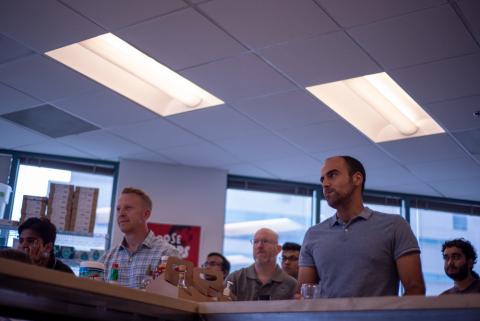[July 2, 2019]
Meet Our Leaders: A Conversation with Brad Holmes

A conversation with Brad Holmes, Shield AI’s VP of Product Development and Software Engineering.
You’ve spent 20 years working at some of the biggest names in tech: Dell, Microsoft, Ericsson and TiVo. Why did you choose to join Shield AI?
I immediately recognized the company focus on the mission driving Shield AI, and I was interested in applying my expertise to help Shield AI realize its goals. My interest grew after I had the opportunity to meet and talk with the team members; I realized it’s a high-performing team made up of a set of individuals with diverse viewpoints.
It’s my belief that throughout one’s career, a person is lucky to have one or two opportunities to be a part of such a motivated team, where everything clicks and each individual knows what the other one is doing. I quickly realized that the folks here all have very unique stories, experiences and a common thread in that they hold closely the sense of team and understand the power of what a team can do by working together. As a result, I chose to be a part of this agile team that believes in the mission and has set an ambitious goal for the company to achieve.
What did you learn from your experiences with large companies on the cutting edge?
In order to have confidence in your products, you must invest heavily in testing them.
I’ve witnessed mistakes made when companies rushed to market without a focus on quality, and it resulted in much longer time-to-market periods than these companies wanted. To build confidence in your products, you must establish reliability. To achieve this, you must harden these cutting edge technologies through a balance of development and testing, while focusing on the details behind the customer behaviors. This balance means that you need to employ just enough process to ensure quality and repeatability, but not so much that you burden the team with undue overhead. While it can be difficult to identify what the right answer to this balancing act is, I have found that delighting the customer is the key to long-term success.
You’ve led global teams that are larger than the entirety of Shield AI. How did you bring everyone together to create a cohesive team? What tools or techniques for leading did you find helpful?
I have traditionally identified end-to-end segments of work that helped drive the overall product together and given autonomy to large swathes of teams that could then properly take these areas, own them with accountability, and provide them with the appropriate set of resource investments so they could execute. This translates to the clear identification and communication of both strategy and tactics such that teams are empowered to make decisions and make progress.
Is there any one particular attribute you think is key to becoming a successful leader?
There are 3 attributes that I associate with leadership and that I have employed heavily throughout my career; accountability, ownership and execution. Wrapping these with order and governance through the deployment of an effective operating model, has led to predictable revenue and on-time results.
With regard to leading people, over my career, I have realized that not everyone responds to the same motivational style, nor do they consume information in the same manner as another person or individual working in a different industry. As a result, I choose to treat people as individuals and stick to principles of respect, accountability, transparency and customer-first.
What advice would you have for those just starting their careers in technology?
Actively listen to those around you. A majority of my personal and career growth has come by way of listening and watching others.
Develop your interpersonal awareness and emotional intelligence. Do not allow the sole focus of your professional development to be your technical prowess — interpersonal connection will enable you to build high-performing, diverse teams that will come together and achieve more together than any one person can do on their own.
In addition, learn as many disciplines as possible. This could be development, test, management, operations or support. As a leader, it’s important to be well-rounded and to understand the business as a whole. And above all, remain humble, but confident.









